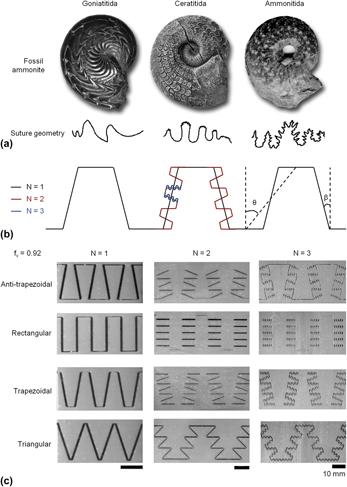Crossref Citations
This article has been cited by the following publications. This list is generated based on data provided by
Crossref.
Lin, Erica
Li, Yaning
Ortiz, Christine
and
Boyce, Mary C.
2014.
3D printed, bio-inspired prototypes and analytical models for structured suture interfaces with geometrically-tuned deformation and failure behavior.
Journal of the Mechanics and Physics of Solids,
Vol. 73,
Issue. ,
p.
166.
Barthelat, F.
2015.
Architectured materials in engineering and biology: fabrication, structure, mechanics and performance.
International Materials Reviews,
Vol. 60,
Issue. 8,
p.
413.
Naleway, Steven E.
Porter, Michael M.
McKittrick, Joanna
and
Meyers, Marc A.
2015.
Structural Design Elements in Biological Materials: Application to Bioinspiration.
Advanced Materials,
Vol. 27,
Issue. 37,
p.
5455.
Niebel, Tobias P.
Carnelli, Davide
Binelli, Marco R.
Libanori, Rafael
and
Studart, André R.
2016.
Hierarchically roughened microplatelets enhance the strength and ductility of nacre-inspired composites.
Journal of the Mechanical Behavior of Biomedical Materials,
Vol. 60,
Issue. ,
p.
367.
Malik, Idris A.
and
Barthelat, Francois
2016.
Toughening of thin ceramic plates using bioinspired surface patterns.
International Journal of Solids and Structures,
Vol. 97-98,
Issue. ,
p.
389.
Frølich, Simon
Weaver, James C.
Dean, Mason N.
and
Birkedal, Henrik
2017.
Uncovering Nature's Design Strategies through Parametric Modeling, Multi‐Material 3D Printing, and Mechanical Testing .
Advanced Engineering Materials,
Vol. 19,
Issue. 6,
Pankonien, Alexander M.
Reich, Gregory W.
Lindsley, Ned
and
Smyers, Brian
2017.
3D-Printed Wind Tunnel Flutter Model.
Mirkhalaf, Mohammad
and
Barthelat, Francois
2017.
Design, 3D printing and testing of architectured materials with bistable interlocks.
Extreme Mechanics Letters,
Vol. 11,
Issue. ,
p.
1.
Djumas, Lee
Simon, George P.
Estrin, Yuri
and
Molotnikov, Andrey
2017.
Deformation mechanics of non-planar topologically interlocked assemblies with structural hierarchy and varying geometry.
Scientific Reports,
Vol. 7,
Issue. 1,
Feilden, Ezra
Ferraro, Claudio
Zhang, Qinghua
García-Tuñón, Esther
D’Elia, Eleonora
Giuliani, Finn
Vandeperre, Luc
and
Saiz, Eduardo
2017.
3D Printing Bioinspired Ceramic Composites.
Scientific Reports,
Vol. 7,
Issue. 1,
Porter, Michael M.
Ravikumar, Nakul
Barthelat, Francois
and
Martini, Roberto
2017.
3D-printing and mechanics of bio-inspired articulated and multi-material structures.
Journal of the Mechanical Behavior of Biomedical Materials,
Vol. 73,
Issue. ,
p.
114.
Malik, I.A.
Mirkhalaf, M.
and
Barthelat, F.
2017.
Bio-inspired “jigsaw”-like interlocking sutures: Modeling, optimization, 3D printing and testing.
Journal of the Mechanics and Physics of Solids,
Vol. 102,
Issue. ,
p.
224.
Hasseldine, Benjamin P.J.
Gao, Chao
Collins, Joseph M.
Jung, Hyun-Do
Jang, Tae-Sik
Song, Juha
and
Li, Yaning
2017.
Mechanical response of common millet (Panicum miliaceum) seeds under quasi-static compression: Experiments and modeling.
Journal of the Mechanical Behavior of Biomedical Materials,
Vol. 73,
Issue. ,
p.
102.
Slesarenko, Viacheslav
Kazarinov, Nikita
and
Rudykh, Stephan
2017.
Distinct failure modes in bio-inspired 3D-printed staggered composites under non-aligned loadings.
Smart Materials and Structures,
Vol. 26,
Issue. 3,
p.
035053.
Lee, Nayeon
Williams, Lakiesha N
Mun, Sungkwang
Rhee, Hongjoo
Prabhu, R
Bhattarai, Kabindra R
and
Horstemeyer, M F
2017.
Stress wave mitigation at suture interfaces.
Biomedical Physics & Engineering Express,
Vol. 3,
Issue. 3,
p.
035025.
Malik, Idris A.
and
Barthelat, Francois
2018.
Bioinspired sutured materials for strength and toughness: Pullout mechanisms and geometric enrichments.
International Journal of Solids and Structures,
Vol. 138,
Issue. ,
p.
118.
Gu, X. Wendy
2018.
Mechanical Properties of Architected Nanomaterials Made from Organic–Inorganic Nanocrystals.
JOM,
Vol. 70,
Issue. 10,
p.
2205.
Gao, Chao
Hasseldine, Benjamin P. J.
Li, Ling
Weaver, James C.
and
Li, Yaning
2018.
Amplifying Strength, Toughness, and Auxeticity via Wavy Sutural Tessellation in Plant Seedcoats.
Advanced Materials,
Vol. 30,
Issue. 36,
Pankonien, Alexander M.
and
Reich, Gregory W.
2018.
Multi-Material Printed Wind-Tunnel Flutter Model.
AIAA Journal,
Vol. 56,
Issue. 2,
p.
793.
Signetti, Stefano
and
Pugno, Nicola M.
2018.
Handbook of Mechanics of Materials.
p.
1.



